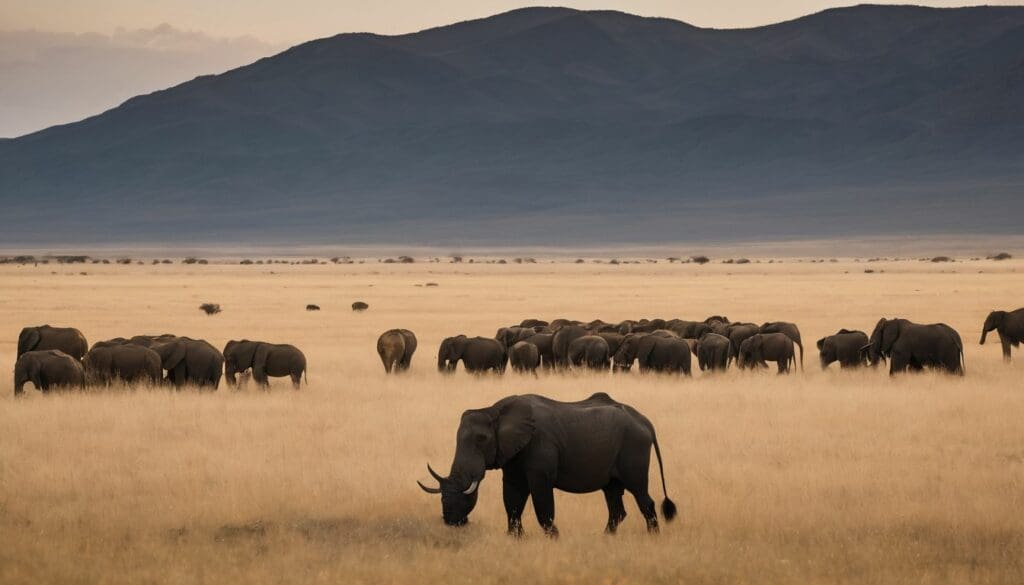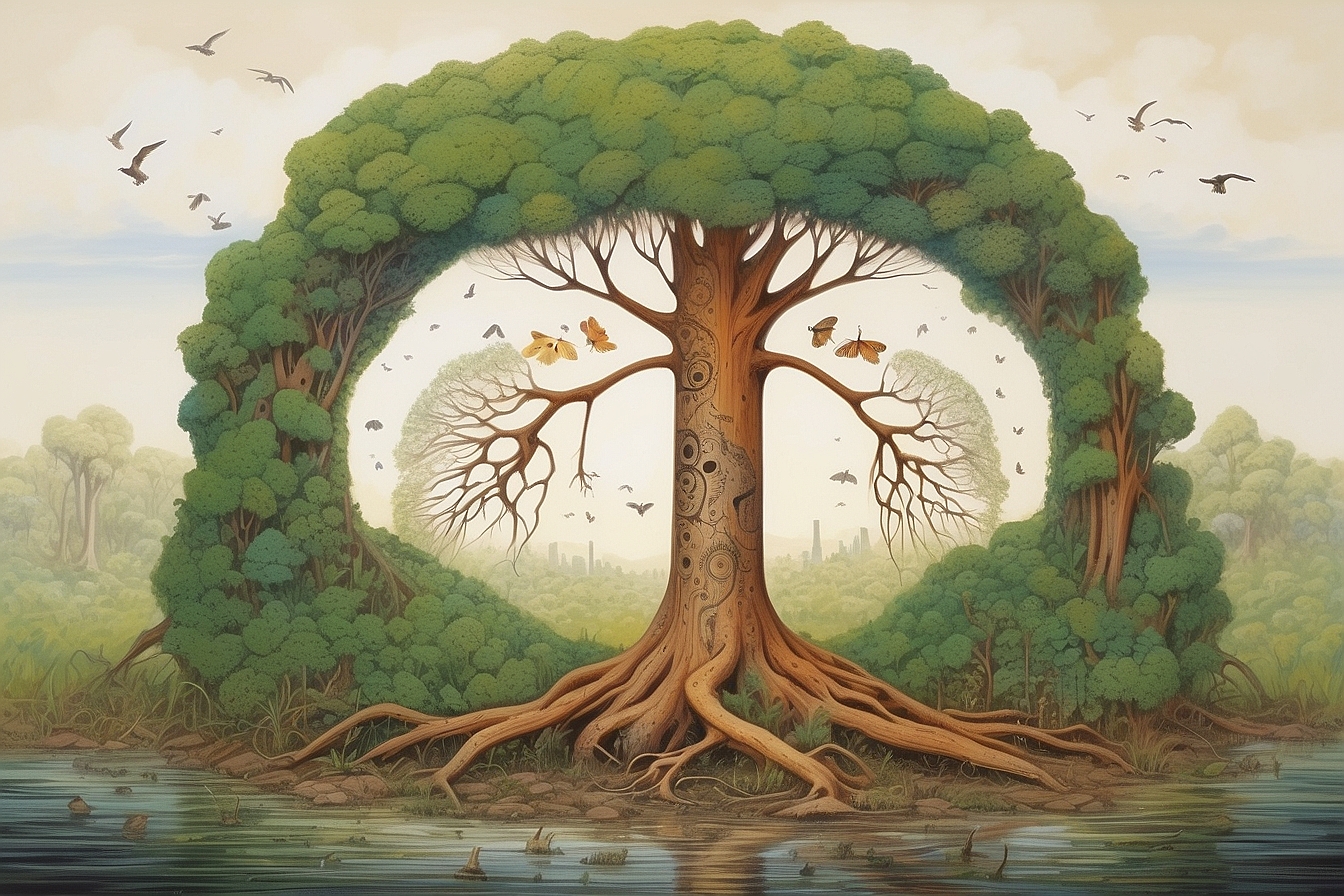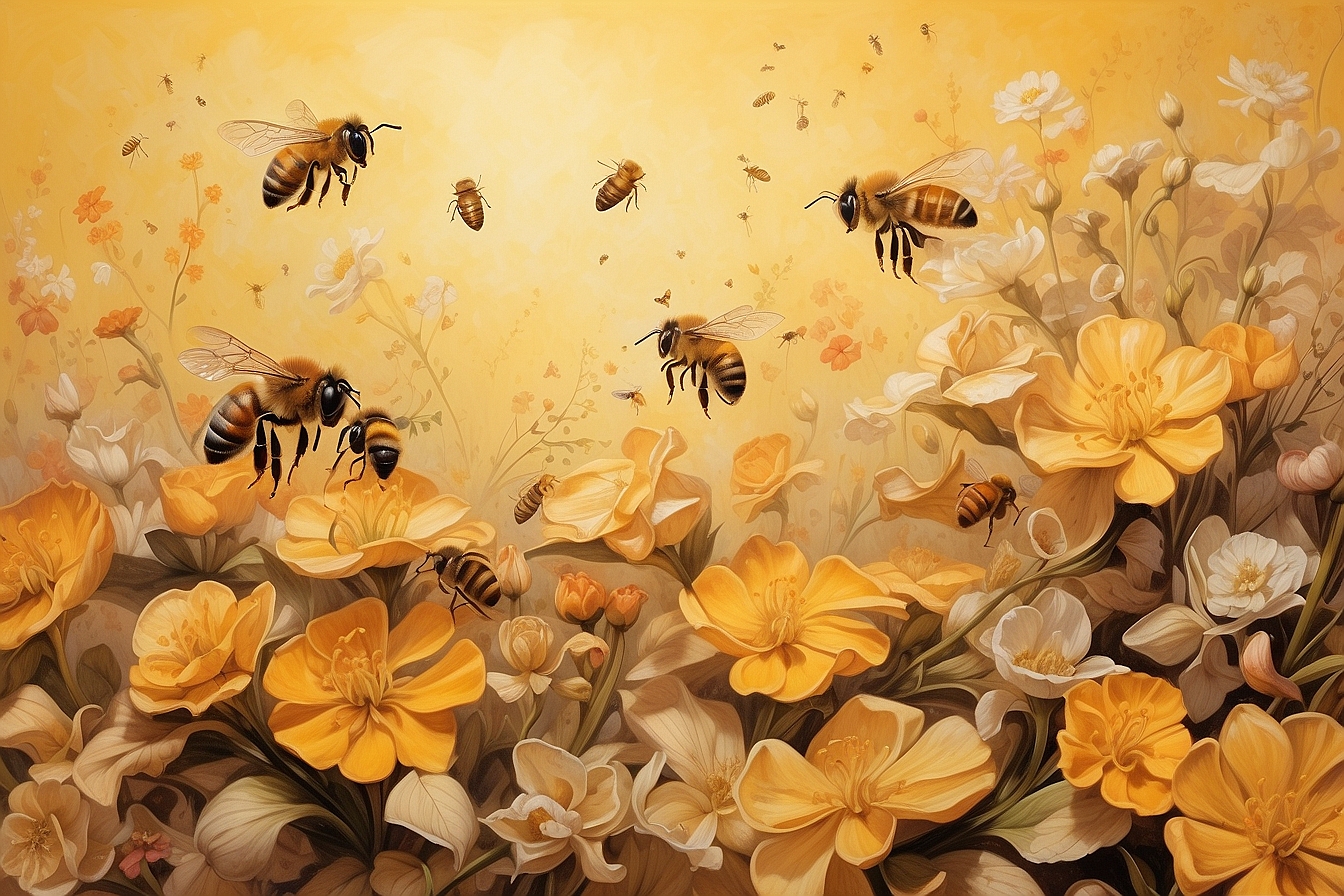The rolling expanses of grasslands that stretch as far as the eye can see have long captivated our collective curiosity. Why do these vast open spaces resist the encroachment of dense forests? We’ve pondered this natural enigma and discovered that herds of roaming herbivores are pivotal to the tapestry of these ecosystems.
Through their appetite for vegetation, they preserve the fragile equilibrium. Our article delicately unravels this intricate dynamic, highlighting how grazing patterns etch the character into savanna landscapes and underscoring their vital role in conservation efforts.
Let us escort you on a meandering journey across Africa’s endless plains, where nature’s grandeur plays out beneath wide skies.
Key Takeaways
- Grazing herbivores like elephants, wildebeest, and zebras are essential to maintaining the grassland ecosystem by preventing young trees from growing into forests.
- Through selective feeding, herbivores promote biodiversity and shape the landscape to support a balance between different plant species in savannas.
- Herbivore dung enriches soil nutrients impacting the stoichiometric balance of ecosystems and supporting plant and animal communities within savannas.
- Small resident herbivores such as rodents also contribute significantly to savanna health by maintaining open spaces that might otherwise become dense thickets.
- Effective management strategies for savanna ecosystems must consider both wildlife conservation and land use, ensuring natural grazing patterns are maintained.
Understanding the Role of Herbivores in Savannas
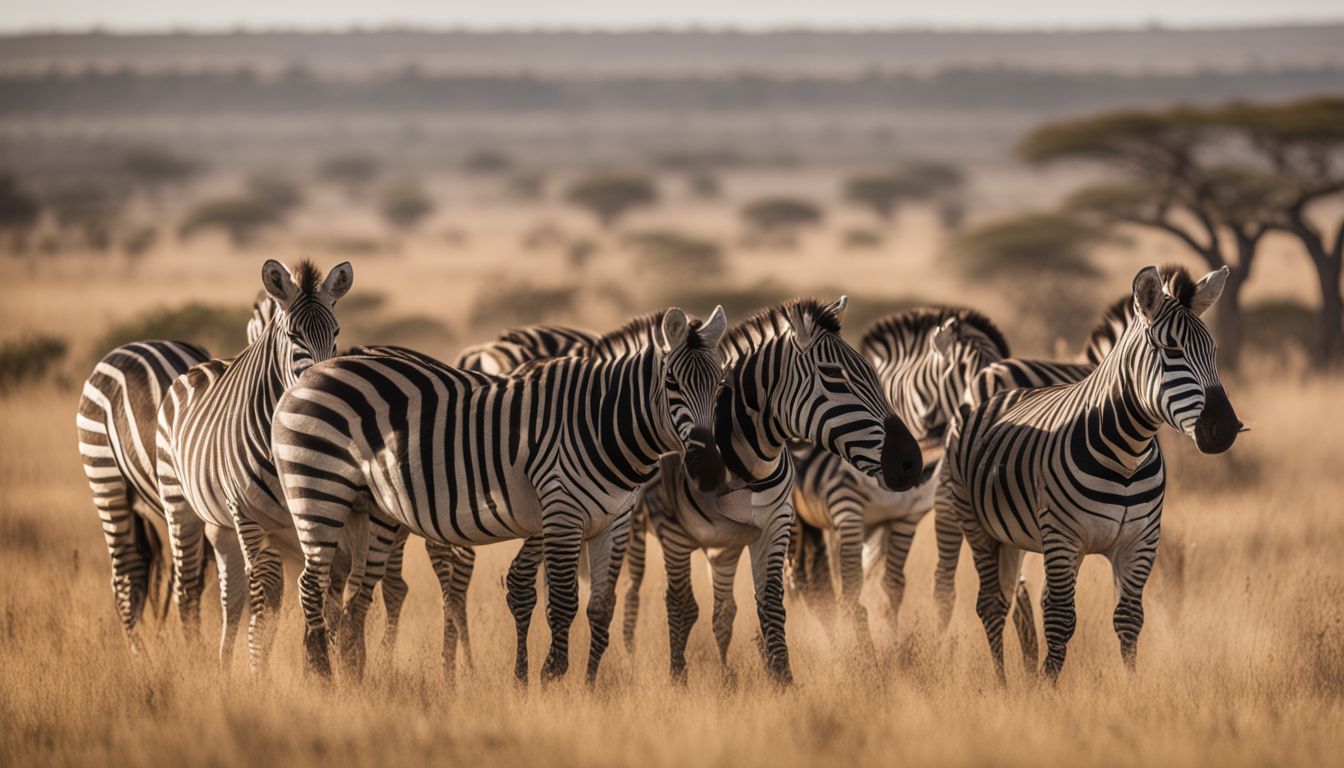
In the vast, open savannas, herbivores are more than just plant-eaters; they shape the very landscape beneath our feet. Their appetite for foliage plays a critical role in crafting the ecological tapestry of these grassy realms.
Grazing lawns and their formation
We observe the fascinating dynamics of grazing lawns within African savannas. These are areas where grasses grow shorter and denser than surrounding regions, primarily due to regular feeding by herbivores.
Elephants, wildebeest, and zebras munch away at the taller blades which leads to a particular type of vegetation that thrives under constant grazing. This continuous cropping ensures only certain species of grass can survive – those that are hardy and grow quickly from their bases.
Our exploration takes us further into understanding how these lawns sustain themselves. They’re like natural gardens maintained by the wildlife; nutrient-rich because grazers stimulate grass growth while their dung fertilises the soil.
It’s an incredible example of ecological engineering where animals shape their environment to suit their needs. Not just any area becomes a lawn; it has to be just right for sunlight, water access, and soil conditions before grazers will cultivate it into a viable feeding ground.
Impact on tree recruitment and woody cover
As herbivores roam the savannahs, they munch on young trees and saplings. This constant grazing hinders these young plants from growing into mature woody cover. Their appetite for tender shoots means fewer trees make it to adulthood, maintaining an open grassland environment ideal for grazers.
Herbivore feeding patterns play a crucial role in shaping our landscapes. Large herbivores such as elephants can push over adult trees, making way for more grasses to grow where once there was dense woodland.
With their size and strength, these animals are nature’s architects of the plains, keeping woody encroachment in check and preserving the savanna as we know it.
Selective grazing and the tree-grass balance
Moving from the broader impacts of herbivores, we now delve into how their feeding habits directly influence the delicate equilibrium between trees and grasses. Selective grazing plays a pivotal role in maintaining this balance within savannas.
Animals don’t just eat any plant they see; they choose specific types, parts, or ages of plants that meet their nutritional needs. This selective pressure can either hinder or promote the growth of certain plant species.
Herbivores such as zebras and wildebeests prefer young, tender shoots of grass, which has an interesting consequence for trees. The constant trimming down of grass allows more sunlight to reach tree seedlings, giving these potential woody giants a fighting chance to thrive amidst the sea of grasses.
However, too much grazing might lead to bare patches where soil erosion occurs and seedlings struggle for survival without protection from harsh elements. Thus, our understanding and management practices must aim at preserving the intricate interaction between grazing patterns and vegetation dynamics that support diverse ecosystems like those found across rangelands worldwide.
The Past, Present, and Future of Herbivore Impacts on Savanna Vegetation
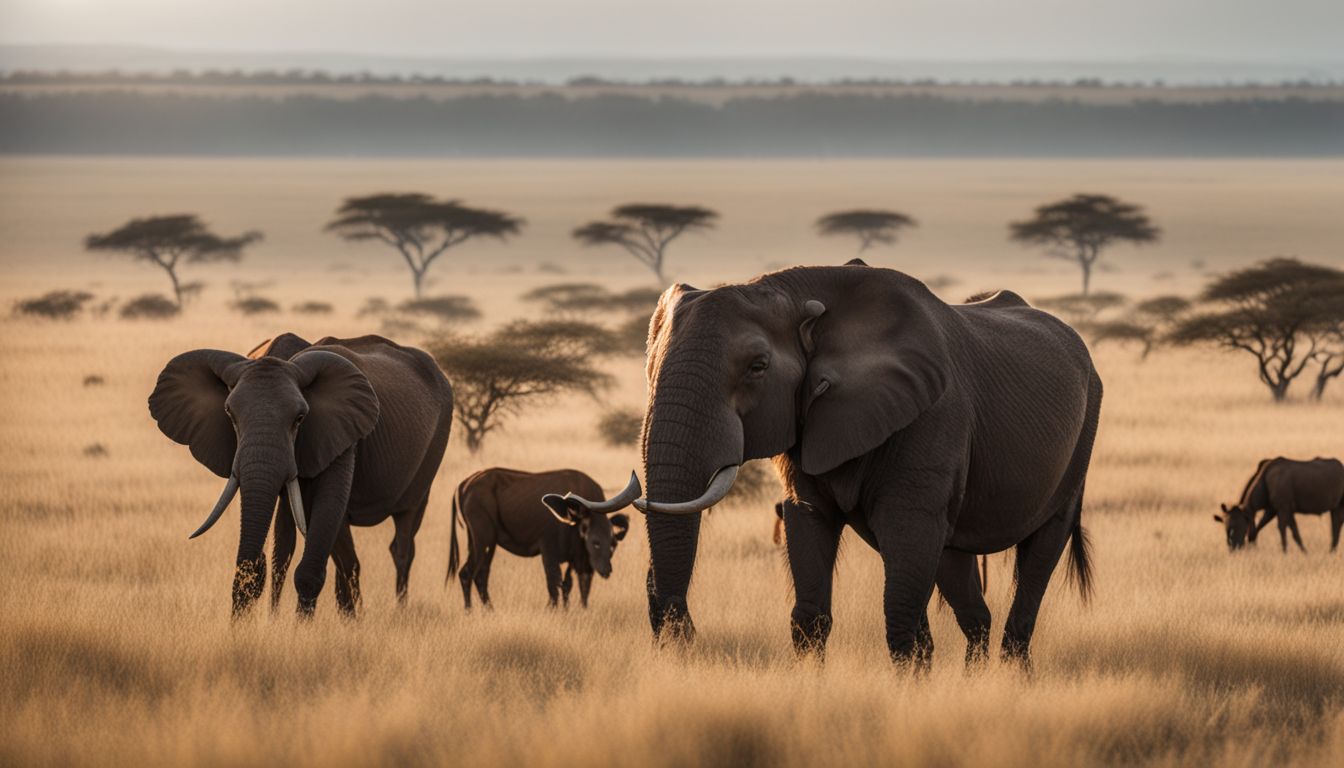
Exploring the intricate dance of herbivores with savanna vegetation unveils a tale of transformation through time. We delve into how these creatures have shaped the grasslands we see today and ponder their role in the savannas of tomorrow.
Determinants of vegetation responses to herbivore exclusion
- Plant species composition shifts dramatically without grazers. In their absence, fast-growing species tend to overtake slow-growers, altering the biodiversity.
- Nutrient cycling gets disrupted. Herbivores play a key role in returning nutrients to the soil through their waste.
- Fire regimes change as a consequence. Dense, ungrazed grass can lead to more intense and frequent fires that reshape the landscape.
- Water availability starts affecting plants differently. Dense plant growth without grazing can reduce soil moisture through increased transpiration.
- Soil compaction varies with herbivore activity. Their movement and weight typically compact the soil, which affects root growth and water infiltration.
- Seed dispersal mechanisms get interrupted. Many plants rely on animals to spread their seeds, a service halted by excluding herbivores.
- Predator – prey dynamics evolve in response. Predators may shift their diets or decrease in number with fewer herbivorous prey around.
The magnitude of vegetation responses to herbivore exclusion
Transitioning from our discussion on the factors influencing how vegetation responds to the exclusion of herbivores, we now turn our attention to the extent of these responses. It’s clear that removing grazers from savannas triggers a cascade of changes in plant communities. Let’s examine the impact in more detail.
| Vegetation Aspect | Response to Herbivore Exclusion | Conservation Insight |
|---|---|---|
| Grass Biomass | Increase in mass and unpalatable species prevalence | Highlights the need for balanced grazing to maintain diversity |
| Woody Plant Encroachment | Higher sapling survival leading to denser woodlands | Points to grazing as a tool to control shrub invasion |
| Plant Species Composition | Shift towards less palatable and more resilient species | Underlines importance of herbivores in species turnover |
| Soil Nutrient Cycling | Reduction in the distribution of nutrients due to less movement | Reinforces the role of herbivores in nutrient dispersion |
| Seed Dispersal | Decrease in dispersion of certain plant species | Emphasises herbivores’ role in maintaining plant diversity |
| Fire Regime | Changes in fuel load may alter fire frequency and intensity | Suggests herbivores indirectly shape fire dynamics |
By understanding these magnitudes, we better grasp the complexities of savanna ecosystems. Each of these elements plays a part in the extensive tapestry that is our environment.
Determinants of herbivore abundance in African savannas and trends over time
Our understanding of the savanna ecosystem shows us that herbivore abundance is influenced by a range of complex factors. Rainfall patterns and water availability crucially dictate where these grazing animals can thrive.
With changing climates, these patterns are shifting, often leading to changes in where herbivores gather and feed. Plant diversity and quality also play significant roles; areas with nutrient-rich grasses support larger populations of grazers.
Human activities contribute another layer of impact on herbivore numbers over time. Land conversion for agriculture, expanding urban areas, and poaching have reduced available habitats significantly.
Conversely, conservation efforts and wildlife management strategies help maintain or increase populations in protected areas. Predation risk from carnivores affects how herds move and disperse across the landscape as well.
Our actions today will influence the future trends of these keystone species’ abundances in our cherished savannas.
The Role of Browsers in Maintaining the Openness of Savanna Grazing Lawns
We explore how browsers contribute crucially to preserving the expansive nature of savanna landscapes by selective feeding, a dynamic essential for both ecosystem health and our understanding of these vibrant habitats; delve deeper to uncover their full impact.
Study of grass height and habitat preference of browsers
In our study, we delve into how different grass heights influence where browsers choose to live and feed. We aim to understand the intricate relationship between these animals and their environment.
- Researchers measure various grass heights across the savanna to see where browsers spend most of their time.
- Observations show that certain species prefer shorter grass, which is easier for them to eat and provides greater visibility for spotting predators.
- The preference for particular grass lengths affects the types and numbers of plants that grow in those areas.
- Data suggests that browsers play a key role in maintaining open areas within savannas by feeding on young tree saplings.
- Scientists also notice that where tall grasses dominate, browsers are less frequent, leading to a change in vegetation structure.
- Browsers’ habitat choices thus directly affect the balance between grasslands and woodlands in the savanna ecosystem.
- Grass height not only impacts availability of food for browsers but also influences their social behaviors and vulnerability to hunters.
- Our team looks at how changes in browser populations might alter these preferences, potentially transforming the landscape over time.
- These findings assist us in recommending conservation strategies aimed at preserving native flora and fauna.
- Understanding these dynamics helps predict future changes within savanna ecosystems under varying environmental conditions.
Seedling and sapling experiment
We’ve delved into the fascinating world of seedlings and saplings with an experiment designed to illuminate their struggles in savanna ecosystems. By introducing various herbivores onto our test plots, we observe firsthand how grazing pressures can either thwart or enable these young plants to thrive.
It’s a dynamic interplay between flora and fauna where every nibble counts.
Our findings are shedding light on trophic interactions crucial for maintaining the balance of these complex habitats. We exclude certain grazers to pinpoint their individual impacts, discovering which species promote growth and which may hinder it.
Such experiments are vital for devising conservation strategies that support both plant and animal life in our world’s precious savannahs.
Long-term tree growth rates along a gradient of grass height
- Trees in open savanna areas often grow slowly. The presence of short grass signals frequent herbivore activity and regular grazing.
- Where grass is taller, it indicates less grazing. These conditions can lead to faster tree growth as seedlings face fewer disturbances.
- We observe that different species of trees respond uniquely to the gradient of grass height. Those adapted to thrive with lots of sunlight tend to stagnate when overtopped by tall grasses.
- Herbivore movement patterns greatly influence this dynamic. They create mosaics where tree growth varies, fostering biodiversity.
- Our studies show a clear pattern of suppressed woody plants where herbivores frequently graze. This phenomenon helps maintain the characteristically open landscapes of savannas.
- Seasonal variations also affect how trees grow along these gradients. With wetter seasons promoting lush grasses, we see a direct impact on the pace at which certain trees develop.
- In managing these ecosystems, we recognise the importance of not just any grazing but strategic grazing patterns which are key in controlling tree cover sustainably.
Impact of Herbivore Dung on Ecosystem Functioning
Herbivore dung plays a crucial role in savanna ecosystems, acting as a vehicle for nutrient redistribution and soil fertility. By examining this from a stoichiometric perspective, we begin to unravel how these natural waste products maintain the delicate balance of savanna life.
A stoichiometric perspective
We often overlook the chemistry behind herbivore dung and its effect on ecosystems, but it’s actually a crucial piece of the savanna puzzle. Herbivore waste acts as a powerful fertiliser, enriching soil nutrients and altering the balance of nitrogen and phosphorus in the environment.
This stoichiometric perspective helps us grasp how these animals sustain grasslands’ health through their droppings.
By including hippo populations in this examination, for instance, we notice their significant impact on water systems due to nutrient runoff from their dung. These contributions trigger a series of ecological processes that support diverse plant and animal communities within savannas.
Understanding this cycle enables us to appreciate ruminants not just as consumers but also as vital contributors to global ecology dynamics.
The Spatial Distribution of African Savannah Herbivores
In the intricate tapestry of the African savannah, herbivores carve out their existence in a pattern as varied and dynamic as the landscape itself – discover how these creatures shape their world and why every patch they tread is vital to the savannah’s story.
Small and resident herbivores
We often focus on the large animals roaming the grasslands, but small and resident herbivores play a crucial role too. These creatures, such as rodents, ground birds, and insects, are constantly at work shaping their environments.
They nibble on grasses and shrubs keeping plant growth in check. This helps maintain open spaces in the savanna that might otherwise turn into dense thickets.
These little grazers also contribute to soil health. As they forage and dig burrows or nests, they aerate the earth allowing water and nutrients to penetrate deeper. Their droppings act like fertiliser contributing to nutrient cycling within these ecosystems.
By doing this day in and day out, smaller herbivores ensure that grasslands remain rich habitats supporting a wide range of life including megaherbivores like elephants and hippos which rely on these landscapes too.
Maintenance of local patches of preferred habitat
In maintaining local patches of preferred habitat, we see herbivores play a crucial role. They create and uphold areas where they can thrive by selectively grazing certain plants whilst avoiding others.
This selective feeding promotes biodiversity and shapes the landscape in ways that suit their needs, ensuring a balance within the ecosystem.
Savanna grazers stimulate growth in grasslands by regularly eating old vegetation, allowing new shoots to sprout. Their movement across the savannas disperses seeds and nurtures soil fertility through dung deposits.
Each species has specific habitat preferences that contribute to varied plant communities and prevent shrub encroachment, preserving these dynamic spaces for future generations of wildlife.
Herbivory: Examination of Mammalian Grazers and Browsers
In our exploration of herbivory, we delve into the pivotal roles played by mammalian grazers and browsers in shaping the savanna ecosystem—join us to uncover their unique contributions.
Role of indigenous mammal herbivores in savannas
We witness the critical function of indigenous mammal herbivores in shaping savanna ecosystems through their eating habits. These animals, from tiny dik-diks to towering giraffes, selectively feed on particular plants and grasses, thereby influencing vegetation patterns across these vast landscapes.
Their grazing activities not only maintain the delicate balance between different plant species but also encourage biodiversity by preventing any one type of plant from dominating.
This diversity is essential for maintaining a robust ecosystem that can withstand changes and support a wide array of wildlife.
Their footprints do more than traverse the land; they press seeds into the soil and create pockets for growth, aiding in plant dispersal. The constant movement of herds also shapes the physical terrain, affecting water runoff patterns and soil composition – elements vital for plant life in savannas.
They serve as architects of their environment, ultimately ensuring that savannas retain their unique ecological character rather than transforming into woodlands or forests due to unchecked tree growth.
Through these actions, indigenous herbivores play an indispensable role in preserving the health and continuity of savanna ecosystems around the world.
Case Study: How Herbivores Prevent African Savannah from Becoming a Forest
In the African savanna, massive herds of grazing herbivores like zebras and wildebeests play a crucial role in shaping their environment. Their appetite for grasses keeps the plant growth in check and prevents young trees from establishing themselves, maintaining the characteristic open landscape.
Without these animals constantly feeding on vegetation, seeds would have ample opportunity to sprout into saplings, potentially transforming the savanna into woodlands over time.
Herbivores also act as natural landscapers by creating patches where they frequently graze known as ‘grazing lawns‘. These spots support particular types of grasses preferred by wildlife, contributing to biodiversity.
Moreover, large mammalian movers such as elephants often knock down trees or strip off bark, stunting tree growth and further helping to preserve the grassland ecosystem from becoming denser forest areas.
Moving onto our next point, we’ll explore how these actions have far-reaching theoretical implications for our understanding of savannas.
Theoretical Implications of Herbivore Impact on Savannas
Herbivores shape savannas in ways that aren’t immediately obvious. They don’t just eat the plants; their munching has led to complex interactions over millions of years, deeply influencing savanna landscapes.
The grazing and browsing habits of these creatures help maintain a delicate balance between grasses and trees. Without herbivores, this unique ecosystem might look very different.
The presence of animals like zebras and wildebeests affects everything from fire patterns to seed dispersal. We see how herbivory can determine the spread and health of various plant species, keeping thickets at bay whilst supporting vast grasslands.
What’s astounding is that these impacts are not random but follow predictable ecological principles. With such knowledge, we turn our focus on how best to manage these dynamic ecosystems for the future.
Management Implications for Savanna Ecosystems
Moving from theory to practice, we see that our understanding of savanna dynamics is crucial for their effective management. Protecting these ecosystems means recognising the fundamental role herbivores play.
We need strategies that support both wildlife conservation and sustainable land use. This includes creating policies that prevent overgrazing while also maintaining natural grazing patterns critical for savanna health.
We advocate for adaptive management approaches which take into account the complex interactions between plants and animals in these landscapes. Incorporating ecological research into rangeland management plans can help preserve biodiversity and ensure the long-term viability of savanna habitats.
It’s vital we use ecosystem services wisely to enhance soil quality, water regulation, and carbon sequestration – all benefits that healthy savannas provide us with every day. With this knowledge, we can develop practices poised to protect these rich biomes against threats like bush encroachment, climate change, and unregulated hunting activities.
Conclusion
In essence, grassland grazers shape the savannas we marvel at. They maintain the delicate balance between trees and grasses, influencing biodiversity and ecosystem health. By understanding their role, we ensure these ancient landscapes thrive for generations to come.
Together, let’s champion the conservation of herbivores as guardians of the savanna. Their survival is key to preserving this unique environment’s splendour and functioning.
FAQs
1. What do herbivores do in the savannas?
In the savannas, like those of the Serengeti Plains, herbivores such as even-toed ungulates eat grass and plants which helps keep the ecosystem balanced.
2. How have animals adapted to live in grassland ecosystems?
Animals on the savanna have evolved special adaptations like fire-tolerant features and complex digestion systems with parts like the rumen for chewing cud.
3. Why is studying animal ecology important there?
Studying animal ecology, including things like herbivore diet and their role in landscape ecology, helps us understand how all life interacts within this environment.
4. Can you tell me about different types of grazers found on grasslands?
Sure! There are mixed feeders that eat a variety of plants, also specific ones adapted to bush-encroachment areas; all contribute uniquely to population ecology dynamics.
5. Does human activity affect grassland grazers and their habitat?
Yes, activities by pastoralists and urban expansion can change natural capital leading to perturbations that impact functional ecology and conservation efforts for animals like black rhinos.
6. Are there efforts to restore or preserve these ecosystems for future generations?
Absolutely! Restoration ecology aims at rewilding habitats while ecological economics studies ways we use natural resources without harming vital places like northern Angola’s savannas.

